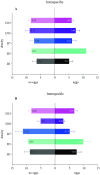Effects of co-occurrence and intra- and interspecific interactions between Drosophila suzukii and Zaprionus indianus
- PMID: 36996013
- PMCID: PMC10062649
- DOI: 10.1371/journal.pone.0281806
Effects of co-occurrence and intra- and interspecific interactions between Drosophila suzukii and Zaprionus indianus
Abstract
In drosophilids, competition and coexistence can impact survivorship, growth, and reproductive output. Here, we evaluated direct competition between two co-occurring fruit flies, the spotted-wing drosophila Drosophila suzukii and the African fig fly Zaprionus indianus, comparing results from field collections with laboratory experiments. Field collections were conducted to evaluate co-occurrence between species. In the laboratory, different densities of eggs of each species were provided an artificial diet, and intra- and interspecific densities were evaluated regarding biological traits such as development and fecundity. Field collections showed a prevalence of Z. indianus, followed by other drosophilid species, including D. suzukii. Pupal survival and adult emergence were higher in D. suzukii than in Z. indianus at both intra- and interspecific densities, with decreasing values in response to increased densities. Fecundity did not differ significantly for either species at different intraspecific densities, but when reared together at different densities, Z. indianus was significantly more fecund than D. suzukii. Development time showed no significant difference at intraspecific densities, but when reared together, Z. indianus had longer development times than D. suzukii. Leslie Matrix projections indicated that D. suzukii showed practically the same dynamics at intraspecific and interspecific densities, with increasing oscillations at low and intermediate densities and decreasing oscillations at high densities. Zaprionus indianus showed a similar oscillation to D. suzukii, except at intermediate intraspecific densities, when the pattern was cyclic. Low interspecific densities resulted in decreasing oscillations. In the two-choice oviposition bioassays, D. suzukii females showed no significant preference for diets previously infested or not with either conspecific or heterospecific eggs at different densities. Understanding competitive interactions between co-occurring heterospecific species should be considered when establishing management tactics for spotted-wing drosophila.
Copyright: © 2023 de Paiva Mendonça et al. This is an open access article distributed under the terms of the Creative Commons Attribution License, which permits unrestricted use, distribution, and reproduction in any medium, provided the original author and source are credited.
Conflict of interest statement
The authors have declared that no competing interests exist.
Figures






References
-
- van der Linde K, Steck GJ, Hibbard K, Birdsley JS, Alonso LM, Houle D. First records of Zaprionus indianus (Diptera: Drosophilidae), a pest species on commercial fruits from Panama and the United States of America. Fla Entomol. 2006;89:402–404. doi: 10.1653/0015-4040(2006)89[402:frozid]2.0.co;2 - DOI
-
- Vilela CR. Is Zaprionus indianus Gupta, 1970 (Diptera, Drosophilidae) currently colonizing the Neotropical region? Drosoph Inf Serv. 1999;82:37–39.
-
- Kato CM, Foureaux LV, César RA, Torres MP. Ocorrência de Zaprionus indianus Gupta, 1970 (Diptera: Drosophilidae) no estado de Minas Gerais. Ciência e Agrotecnologia. 2004;28:454–455. doi: 10.1590/s1413-70542004000200029 - DOI
-
- Leão BFD, Tldon R. Newly invading species exploiting native host-plants: The case of the African Zaprionus indianus (Gupta) in the Brazilian Cerrado (Diptera, Drosophilidae). Ann Soc Entomol Fr. 2004;40:285–290. doi: 10.1080/00379271.2004.10697427 - DOI
Publication types
MeSH terms
LinkOut - more resources
Full Text Sources
Molecular Biology Databases

